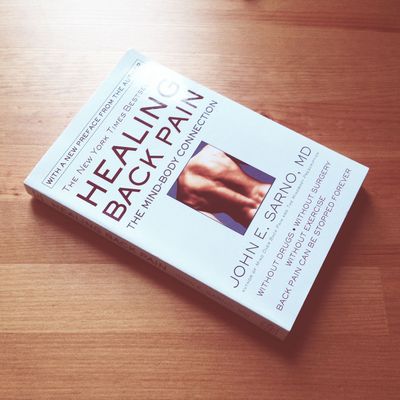
A few months ago, I interviewed the sobriety writer Annie Grace. We had a good talk about alcohol, and at one point she mentioned a book that had been influential for her. It had nothing to do with booze, she said, but it was relevant regarding the mind-body connection: Healing Back Pain, by an NYU physical rehabilitation doctor named John E. Sarno. We then moved on to discuss other things (Grace also mentions Healing Back Pain in her own work), but I Googled the book and the author, and it stuck in my mind.
Originally published in 1991, Healing Back Pain has apparently helped thousands of people recover from chronic pain, without drugs, surgery, or exercise, as the cover copy puts it. (About 50 million Americans, or 20 percent of the population, currently struggle with chronic pain.) Hundreds of people have shared their miraculous-sounding stories of Sarno-influenced transformation on an independent website called Thank You, Dr. Sarno. (“I know you never liked hearing it, but I owe my life to you,” the latest entry reads.) I was curious. I ordered the book.
Sarno’s central idea is simple (and the book itself is short): Chronic physical pain can sometimes be the result of emotional tension. We can feel measurable, quantifiable pain throughout our bodies, he writes, in response not to injury but to emotional distress. And our minds create this pain (often by depriving certain body parts of oxygen) in order to distract ourselves from these “unacceptable” emotions, such as anxiety, anger, and fear. When unaddressed or repressed, he says, these emotions can essentially be churned subconsciously through the body to emerge elsewhere as physical pain. Unaddressed rage, for instance, can become back pain (or neck pain, or pain anywhere). “Unconsciously,” he writes, “we would rather have a physical pain than acknowledge any kind of emotional turmoil.”
Damn, I thought. Is this right, or is this insane? I don’t have back pain, but I was tempted to pass the book on to people I know who do. Similar to booze, though, it’s a touchy subject. If I were considering surgery for a herniated disc, for example, would I want to get a random email suggesting that my pain and numbness were because I couldn’t deal with my emotions? Sarno himself didn’t believe that herniated discs and other supposed spine abnormalities typically caused pain — he called them “normal abnormalities,” citing studies that show that spine abnormalities don’t necessarily cause discomfort. (The mainstream medical community “generally dismissed his theories as simplistic and unscientific,” per his New York Times obituary.) Pain “seems a heavy price to pay” for emotional distress, Sarno writes, “but then the inner workings of the mind are not really known, and we can only suspect its deep aversion to frightening, painful feelings.” (He doesn’t suggest that all physical pain has an emotional cause, of course, and he encourages readers who suspect they have acute injuries or illnesses to seek help from other doctors.)
Sarno died in 2017, at 93, shortly before the release of a documentary about his life and teachings, called All the Rage (Saved by Sarno). The documentary includes testimonials from Larry David, Howard Stern, John Stossel, and Jonathan Ames, among others. I was struck by David’s description of his experience using Sarno’s method: “It was the closest thing that I’ve ever had to a religious experience in my life,” he said, “and I wept.” Is this all for real? I’m vaguely friendly with Ames, from crossing paths with him at a bar in Brooklyn years ago, so I emailed to say I’d been glad to see him in the documentary. “I love that book,” he said. “It was transformational.” He added, “My back pain has definitely been something for me to learn from — it is a red flag or flare from my body telling me that something is going on emotionally that I need to face.”
The idea that serious pain might be mental in origin rather than physical is both attractive (what if it were that simple?) and repellent (what the hell?). Reading the book felt like toeing a strange kind of threshold. What do I want to believe; how far do I go? Later in the book, when Sarno mentions, almost as an afterthought, that other maladies like acne, allergies, and migraines might also be emotional, I wanted to hold the book away from me. (But, what if they are?) In any case, I’m open to the idea of emotional repression having serious costs. Also to the mind being more powerful than we often give it credit for. There was a time in my life when I was struggling to handle recurrent and overwhelming negative emotions, specifically anger and fear surrounding a relationship I felt I had no control over. It was uncomfortable to be so upset, and I felt the need to conceal and transform it. (This still seems like a reasonable response.) I tried to squeeze the anger into more proactive shapes, but daily life still often felt like an act. I wasn’t in physical pain, but the unresolved fear and frustration felt like they were corroding some essential part of me, sort of like emotional heartburn. Eventually the relationship ended.
For situations you can’t easily extract yourself from (and most sources of anger and anxiety — such as children, parents, and spouses — aren’t easily avoidable), Sarno recommends things like journaling, talking about emotions with trusted acquaintances, and going to a therapist. Apparently, just being aware of the connection between emotions and physical pain can be enough to allow pain to recede, in his telling. “Knowledge is the only prescription that I have,” he said, in the documentary.
Sarno’s obituary included an anecdote about NYU colleagues who would belittle him in public but visit him in private, and that seems about right.




